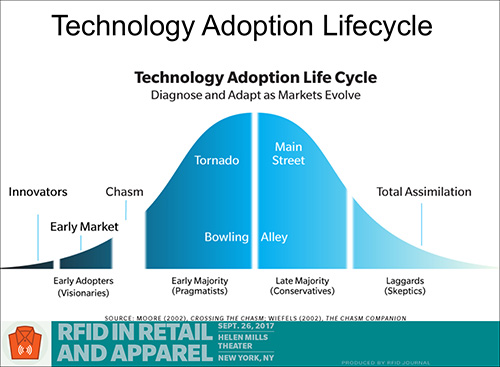It’s been clear for the past few years that retail apparel will be the first market to adopt radio frequency identification technology on a large scale. Apparel is RF-friendly, and each item comes in a variety of colors and sizes, making it difficult to manage inventory effectively. The big question has been when the sector will reach the tipping point. The answer: when virtually all apparel manufacturers tag all of the items they produce, and all retailers start using the tags to better manage their inventory and enable their omnichannel strategy.
Data presented at last week’s RFID in Retail and Apparel 2017 event suggests that adoption of RFID is accelerating quickly. Dr. Bill Hardgrave, the dean of Auburn University’s Harbert School of Business, presented a slide indicating that of the top retailers doing something with RFID, 50 percent are now at some stage of deployment, approximately a third are in the proof-of-concept stage, and 15 percent are piloting. There was a nine percent decrease in the number piloting the technology and a 71 percent increase in the number that have deployed RFID in some way, indicating the industry is moving from the pilot phase to the adoption phase.

Hardgrave added that there was a 39 percent increase in the number of retailers doing something with RFID in 2017, over 2016. That led to a 29 percent increase in the number of apparel retailers launching proofs-of-concept. “There was a huge jump this year in the number of retailers that are deploying,” he stated, “versus last year.” Market research indicates that some 8.5 billion passive ultrahigh-frequency (UHF) RFID tags will be used on apparel items this year, but that is still only a fraction of the total number of apparel items sold each year.
I spoke to several other exhibitors who said that they are seeing a significant uptick in adoption. There are several large requests for proposal out from retailers. I also spoke to attendees from well-known brands (which I cannot name), who said that they were looking to roll the technology out globally.

I presented a slide at the event (above) showing the technology adoption lifecycle, according to Geoffrey Moore, the author of Crossing the Chasm. Moore wrote that new technologies are adopted by early visionaries, but that the market then drops off because there is a “chasm” between the early visionaries and the majority of companies, which are reluctant to bet on new technologies that have not yet shown a proven benefit. Eventually, the technology matures and climbs out of the chasm. Practical companies then begin adopting it in a specific industry in which it delivers clear benefits. Once adoption in that sector reaches a tipping point, the technology takes off and everyone in that sector uses it.
I always show the slide to make the point that adoption during the next five years will not be at the same pace as the last five years. At some point, RFID will take off and all retailers will be forced to use it. I encourage companies to learn now and prepare, because RFID is clearly getting closer to that tipping point, and it is better to ride the adoption wave than be crushed by it.
Mark Roberti is the founder and editor of RFID Journal. If you would like to comment on this article, click on the link below. To read more of Mark’s opinions, visit the RFID Journal Blog, the Editor’s Note archive or RFID Connect.

